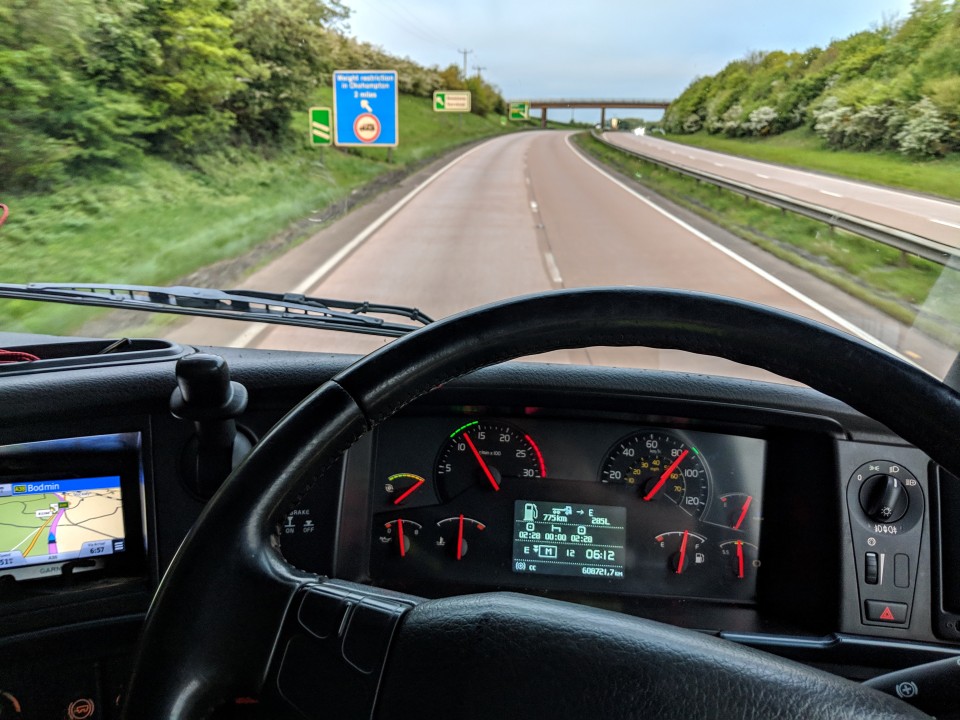
Susie Jones
Regulile tahografului, simplificate
Creat: 01.08.2024
•
Actualizat: 08.08.2024
Lumea regulilor tahografului poate fi un loc confuz pentru cel mai experimentat șofer de camion. Cu atât mai puțin pentru oricine intră recent în industrie. Scopul nostru este să clarificăm o parte din această confuzie.
Ce este un tahograf și de ce îl avem?
Conform dicționarului, tahograful este "un dispozitiv montat pe vehicule precum camioanele și autocarele pentru a înregistra informații precum viteza cu care circulă vehiculul, distanța parcursă și numărul de pauze luate de șofer".
Scopul tahografului este de a preveni oboseala șoferilor și de a asigura respectarea normelor de către șoferi și angajatori. [Organizația caritabilă pentru siguranța rutieră Brake] (https://www.brake.org.uk/get-involved/take-action/mybrake/knowledge-centre/driver-fatigue) a raportat că "patru din zece accidente legate de oboseală implică o persoană care conduce un vehicul comercial". Prin urmare, normele privind tahograful joacă un rol esențial în încercarea de a reduce acest număr.
Când aveți nevoie de un tahograf?
Trebuie să montați un tahograf dacă greutatea brută a vehiculului dumneavoastră depășește trei tone și jumătate. Este important să rețineți că acest lucru include tragerea unei remorci. Există câteva excepții de la această regulă:
Dacă conduceți numai pe drumurile publice
Dacă vehiculul este condus de forțe armate, poliție sau pompieri
Dacă sunteți o flotă comercială și folosiți vehicule cu o greutate maximă de șapte tone și jumătate, iar călătoria dvs. este la mai puțin de 100 km de baza dvs. de operare.
Dacă transportați mărfuri și vehiculul dumneavoastră este electric
Dacă transportați echipamente sau utilaje pentru uzul șoferului, iar conducerea acestui vehicul nu este activitatea dumneavoastră principală.
Care sunt diferitele tipuri de tahografe?
Există trei tipuri diferite de tahografe:
Analogice: Acestea au devenit obligatorii în Europa în 1986. Tahografele analogice folosesc foi de hârtie cerată pentru a înregistra datele șoferului. Conducătorii auto introduc manual datele și le introduc într-un aparat de tahograf.
Digital: Acestea au fost introduse în 2006. Sunt utilizate de peste un milion de companii de transport și de peste șase milioane de șoferi profesioniști. Tahografele digitale înregistrează datele șoferului pe un dispozitiv intern de stocare și pe cardul șoferului.
Inteligent: Din iunie 2019, Uniunea Europeană a impus companiilor să utilizeze tahografe inteligente. Acestea înregistrează automat locația vehiculului la începutul și la sfârșitul fiecărei călătorii. De asemenea, acestea furnizează actualizări la fiecare trei ore
Ce înseamnă fiecare simbol al tahografului?
Check out our video explaining each tachograph symbol
Reguli de pauză
Pentru siguranța șoferului de camion și a tuturor celorlalți participanți la trafic, trebuie respectate regulile de pauză. Am enumerat punctele cheie.
Timp de conducere:
- Nu poate fi mai lung de patru ore și jumătate înainte de o pauză
Pauze:
- Trebuie să fie de cel puțin 45 de minute, cu excepția cazului în care șoferul ia o perioadă de odihnă
Perioada de repaus:
- În timpul unei perioade de repaus, nu se poate conduce sau efectua orice altă activitate
Împărțirea pauzelor:
O pauză completă de 45 de minute poate fi împărțită cu o pauză de 15 minute urmată de una de 30 de minute
Pauzele de fracționare trebuie distribuite pe parcursul celor patru ore și jumătate de condus
În conformitate cu normele UE, dacă pauzele sunt fracționate, a doua pauză trebuie să fie de cel puțin 30 de minute.

Limita zilnică de conducere
Limita zilnică de conducere se referă la timpul maxim de conducere într-o zi. Nouă ore este durata maximă, dar aceasta poate fi mărită la 10 ore. Totuși, acest lucru nu poate fi făcut de mai mult de două ori într-o săptămână fixă. Timpul zilnic de conducere poate fi definit ca:
Timpul total de conducere acumulat între sfârșitul unei perioade de repaus zilnic și începutul următoarei perioade de repaus zilnic
Timpul total de conducere acumulat între o perioadă de repaus zilnic și o perioadă de repaus săptămânal. .
Limita de conducere săptămânală și bisăptămânală
Conducătorii auto trebuie să se asigure că nu depășesc limitele maxime de conducere săptămânale și bisăptămânale.
Limita maximă de conducere săptămânală este de 56 de ore (se aplică la o săptămână fixă)
O săptămână fixă începe la ora 00.00 și se încheie la ora 24.00 în duminica următoare
O limită de conducere pe două săptămâni este de 90 de ore.
Odihnă zilnică
În plus, trebuie să vă odihniți zilnic.
Șoferul trebuie să se odihnească 11 ore neîntrerupte. Aceasta poate fi redusă la nouă
Această reducere poate avea loc doar de trei ori între perioadele de repaus săptămânal
Perioada de repaus trebuie să fie încheiată în termen de 24 de ore de la sfârșitul ultimei perioade de repaus zilnic sau săptămânal.
Odihna zilnică poate fi luată în vehicul; cu toate acestea, sunt necesare facilități de dormit adecvate. Dacă aceste facilități lipsesc, șoferul trebuie să găsească cazare. Consultați pagina noastră locații pentru a afla care stații de camioane oferă acest serviciu.
Repaus săptămânal
Perioadele de repaus săptămânal trebuie să fie luate cel târziu la sfârșitul a șase perioade consecutive de 24 de ore de la sfârșitul ultimului repaus săptămânal.
Șoferii sunt obligați să se odihnească cel puțin 45 de ore
Aceștia pot beneficia de un repaus săptămânal redus de cel puțin 24 de ore
Odihna săptămânală redusă trebuie să fie compensată într-un bloc și cu cel puțin nouă ore înainte de sfârșitul celei de-a treia săptămâni.
Deși se poate lua repaus redus, merită să rețineți că în două săptămâni consecutive în care s-a luat repaus redus, una trebuie să fie de 45 de ore.

Echipaj multiplu
Unii șoferi pot lua un alt șofer la bord. Printre beneficii se numără creșterea productivității, kilometrajul mai mare parcurs și timpul de condus mai lung.
Ambii șoferi trebuie să beneficieze de nouă ore de odihnă zilnică
Această odihnă zilnică trebuie să fie luată în decurs de 30 de ore, nu de 24 de ore.
În prima oră de multi-manning nu este necesar un alt șofer. După o oră, acesta devine obligatoriu.
Traversări cu feribotul sau călătorii cu trenul
După cum s-a menționat mai sus, perioada de odihnă zilnică obișnuită a unui șofer trebuie să fie de 11 ore neîntrerupte, însă există câteva excepții de la această regulă. Cu condiția ca vehiculul să fie însoțit de șofer; perioadele de odihnă zilnică pot fi întrerupte de două ori, dar nu trebuie să depășească o oră în total. De exemplu, îmbarcarea și debarcarea pentru feriboturi și trenuri.
În cazul în care perioada obișnuită de odihnă zilnică este întreruptă în acest mod, perioada de odihnă acumulată trebuie să fie de cel puțin 11 ore sau 12 ore dacă este fracționată.
Ce este regula tahografului de un minut?
Regula unui minut a intrat în vigoare în octombrie 2011. Aceasta se referă la o legislație mai veche care prevedea că un minut cu cel puțin cinci secunde de conducere trebuia înregistrat ca timp de conducere. Cu toate acestea, UE a modificat această legislație, astfel încât cea mai lungă activitate continuă desfășurată într-un minut va fi înregistrată ca activitate specifică.
Ce se întâmplă dacă nu respect regulile tahografului?
Nerespectarea normelor privind tahograful poate duce la amenzi și, uneori, la închisoare. În general, pedeapsa depinde de gravitatea încălcării. Cele mai multe încălcări ale tahografului sunt tratate cu sancțiuni fixe. Șoferii au la dispoziție până la 28 de zile pentru a lua în considerare sancțiunile fixe.
Există două tipuri de amenzi și sancțiuni în Regatul Unit.
Amenda de nivel patru: Acestea sunt plafonate la 2 500 de lire sterline; acest plafon este pentru fiecare amendă de tahograf. Cu toate acestea, cazurile cu mai multe încălcări de nivel patru ar putea primi o amendă maximă pentru fiecare încălcare.
Amenda de nivel cinci: Acestea sunt plafonate la 5 000 de lire sterline, însă, la fel ca în cazul amenzilor de nivel patru, cazurile cu încălcări multiple ar putea ajunge la amenda maximă.
Regulile tahografului pot fi greu de înțeles. Cu toate acestea, nerespectarea lor ar putea duce la probleme de siguranță și potențiale amenzi. Prin înțelegerea și respectarea normelor, flotele și șoferii își pot folosi vehiculele în siguranță și legal. Este esențial să rețineți că normele și reglementările privind tahograful pot varia în funcție de țară.



